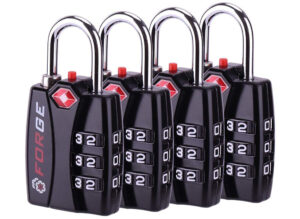Think you won’t lose valuables if you check them in your bag? Think again. There were more than 34,000 claims of lost or damaged items filed at the 15 busiest U.S. airports between 2010 and 2017, and about 40 percent of them were denied. And that’s not the only thing that can go wrong when checking a bag. Check out the following tips to help you avoid common pitfalls and ensure that your luggage—and you—arrive in one piece.
Don’t Pack Valuables in Your Checked Bag
I’ll start with the obvious, since it seems that many travelers still haven’t learned this vital lesson. (Among the items that were stolen out of checked bags over the past few years are a $5,000 watch, gold rings, iPads, and cameras, according to CNN—all things that should never have been checked in the first place.)
As a general rule of thumb, you shouldn’t pack anything in your checked bag that you can’t permanently part with or that has a high monetary value. If you need to check your bag at the gate, be sure to remove vital items such as laptops, tablets, smartphones, prescription medications, and—perhaps most importantly—your passport.
Pricey souvenirs that you purchase during your travels should be protected in your carry-on or, if they’re too large, well packaged and shipped home; be sure to get insurance on the package as well as a tracking number so you’re covered in case of loss or breakage.
Don’t Pack Items on the TSA’s Prohibited List
It’s no surprise that fireworks and other flammable items are prohibited in checked (and all) baggage, but did you know you can’t pack certain types of batteries? It’s okay to slip a few AAs in your checked luggage, but loose lithium batteries—such as those used in cameras—must be packed in your carry-on, and wet/spillable batteries (the kind found in cars) are prohibited unless they’re part of an electric wheelchair.
Also verboten: strike-anywhere matches, electronic cigarettes (those can go in your carry-on), and, on many airlines, hoverboards. Double-check the TSA’s list of prohibited items before checking a bag.
Don’t Use a Non-TSA-Approved Lock
If your luggage needs to be physically inspected, a non-TSA-approved lock will be ripped off your bag at security—it’s that simple. Purchase one that’s been okayed by the TSA (which means that security officers can open it with a master key); the lock should be advertised as such on the label.
Use Approved Locks to Get Through TSA Safely and Securely
Although airport security does its best, there is no guarantee all of your belongings will be waiting for you at baggage claim. Save yourself the anguish after potentially getting your items stolen out of an unlocked bag by getting TSA-approved locks for your luggage.
Don’t Leave Any Loose Ends
Be sure all of the compartments and pockets on your bag are securely zipped and fastened, and don’t leave anything hanging outside of it, such as shoes laced to a handle or backpack straps dangling in all directions. These items can easily get caught on the conveyor belt at the airport and get either destroyed or lost.
Don’t Book a Tight Connection
The shorter your layover, the bigger the chance your bag won’t make it to final destination with you. Of course, most times the bag does make it, but the stress of wondering whether or not it will arrive can be eliminated with a longer layover. I recommend at least two hours, or even longer for international transfers that require you to reclaim and then recheck your bag before getting onto your next flight.
Don’t Put Liquids in a Bad Spot
Be careful about the way you pack shampoo, lotion, and other liquids. “I once had to gate-check my carry-on, which had my plastic bag of 3.4-ounce liquids and gels right in the front pocket where I could easily access it in the security line,” says SmarterTravel Senior Editor Sarah Schlichter. “I didn’t think about it when I handed the bag over at the gate, but I discovered when I got it back that my bottle of shampoo had exploded, probably when a baggage handler tossed the suitcase onto a cart. Oops! I should’ve cushioned my liquids inside the main compartment of the bag instead.”
To prevent other toiletry mishaps, try taping your liquid bottles with duct tape and putting them in a well-cushioned plastic bag. (You may not even need to pack all of them—check which toiletries will be available at your hotel.) If transporting alcohol, roll the bottles up in layers of clothing or bubble wrap.
Don’t Travel with an Unmarked Bag
It’s not uncommon for people to grab the wrong suitcase by accident at baggage claim. Make it less likely by tying a colorful ribbon to your luggage or using a unique baggage tag—anything to make your suitcase stand out in a long line of black and navy bags. Even better? Use a bag with a vibrantly colored or patterned exterior.
Don’t Get Too Close to the Weight Limit
On many airlines, checked bags can weigh up to 50 pounds—and if you exceed the limit, the charges rack up fast. If you tend to be a heavy packer, purchase a small luggage scale to help you make sure you’re within the limit. Note that you shouldn’t get your bag down to 49.9 pounds and call it a day; airport luggage scales aren’t always accurate, so you’ll want to allow a little room for error. (Bonus: That’ll leave you room to bring home a few souvenirs, too.)
Don’t Gate-Check a Bag That Can Fit Under Your Seat
It’s typically free to check a bag at the gate when an aircraft runs out of overhead storage space, but only do so if you have a bag that’s worth checking. A backpack or small bag can easily fit under your seat with legroom to spare, eliminating the need to wait around for another piece of luggage at baggage claim.
Don’t Pack All of Your Clothes in Your Checked Bag
You’ve probably heard it’s good to pack an extra pair of underwear or an entire outfit in your carry-on just in case your checked suitcase is lost, but here’s another reason to pack clothing in your hand luggage: You might get cold. Airports are often chilly, and in the event your seatmate feels the need to blast the air vent in the dead of winter, you’ll be happy to have a hoodie and maybe even some warm socks to be comfortable on the plane.
Need more help? See The Definitive Guide to Everything You Can (and Can’t) Pack in Your Checked Luggage.
Now that you’ve figured out what to do when checking a bag, don’t miss 7 Things Not to Do When Packing a Carry-on Bag.
More from SmarterTravel:
Editor’s note: This story was originally published in 2017. It has been updated to reflect the most current information.
We hand-pick everything we recommend and select items through testing and reviews. Some products are sent to us free of charge with no incentive to offer a favorable review. We offer our unbiased opinions and do not accept compensation to review products. All items are in stock and prices are accurate at the time of publication. If you buy something through our links, we may earn a commission.
Related
Top Fares From
Today's Top Travel Deals
Brought to you by ShermansTravel
4-Night Grand Canyon & Las Vegas...
Great Value Vacations
 vacation
$772+
vacation
$772+
Greek Isles: Luxe Last-Minute, 7-Nt, All-Incl....
Regent Seven Seas Cruises
 cruise
$8599+
cruise
$8599+
Asia: Business Class Round-Trip Flights to...
Business-Class
 Airfare
$2249+
Airfare
$2249+








